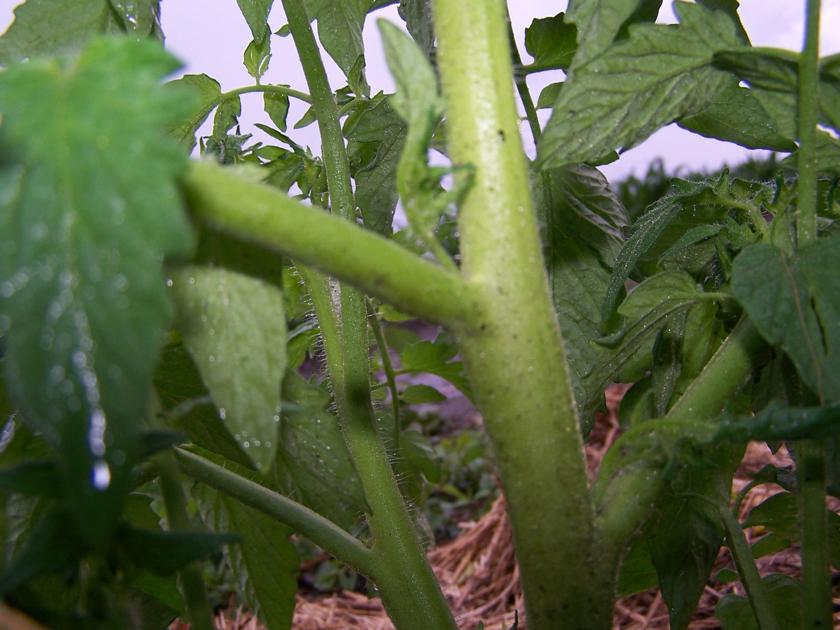
The main goal of pruning and staking tomatoes is to keep the fruits off the soil and promote air circulation within the foliage of the plant.
Pruned plants produce bigger and earlier fruits because more of the plant energy is channeled into fruit production and ripening and not into the branches and leaves. Pruning is a good cultural practice that can slow and control the spread of disease.
Suckers are described as leafy growths that often appear between the crotch of the main stem and the branches. They are sometimes referred to as secondary branches.
Remove a sucker when it is about 4 inches long. Letting a sucker grow much longer could result in damage to the plant when it is removed.
Grasp it between your thumb and second finger, then bend it to the side until it breaks. Perform this task early in the day while the plant tissues are crisp.
A knife or pruner can be used but must be cleaned with a solution of bleach and water (two cap-fulls of bleach to one gallon of water) to ensure a disease free cut. Remove and discard the pruned branches to the compost pile.
Any stems or leaves that turn yellow should be removed right away. Never place diseased foliage on the compost pile.
Bush or determinate tomatoes grow to about 3 feet and stop growing when fruit sets on the top bud. All the tomatoes ripen at about the same time, in one to two weeks. They will need a limited amount of staking and are perfect for container growing.
Some say to prune a determinate and some say not to. Me, I like to prune.
A determinate tomato will produce only so much fruit. Keep in mind that if you do prune, you are taking away some of the fruit producing branches.
I like to prune suckers and branches at the bottom 5 to 7 inches. Pruning will increase air flow at the base of the plant and reduce the risk of attracting insects and disease with the possibility of fruits resting on the ground.
I would rather deal with fewer tomatoes than insects and disease. Pruning the bottom branches also makes weeding and fertilizing at the base of the plant easier.
Some gardeners prune heavy branching in the middle of a tomato plant to increase air circulation. If this is done you must be careful not to prune too much of the foliage though as the fruits need to be shaded to prevent sunscald (over-exposure to the sun).
Indeterminate tomatoes will keep on growing and producing fruit until the first frost. They will require a large amount of space to sprawl.
It is recommended, but not a must, to pinch suckers on an indeterminate plant throughout the growing season to prevent the plant from getting too heavy and unmanageable.
The size of the plant will depend on what staking or caging it is growing on.
Staking or caging tomato plants is a must. It helps to keep the plant healthy and keeps the fruit from rotting on the ground.
While there is a wide variety of supports available, I have found that a section of a metal cattle panel resting horizontally on concrete blocks works very well to support growing plants.
A cattle panel can also be bent to rest between four metal fence posts to act as a vertical growing support. It is best to set the support structure in place at the time of planting.
As always, Happy Gardening!
July 10, 2020 at 11:00AM
https://ift.tt/38GcGF8
Prune tomato plants to prevent disease, increase air flow - KPCnews.com
https://ift.tt/2VAxJ6V
Tomato

No comments:
Post a Comment